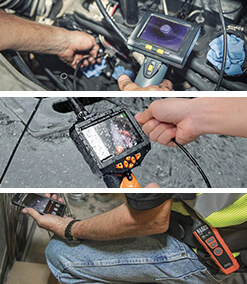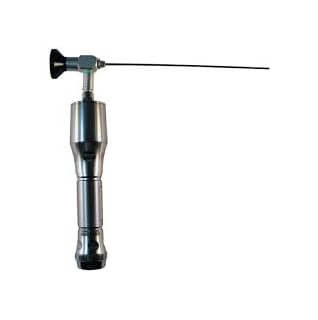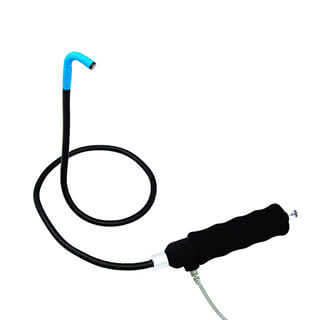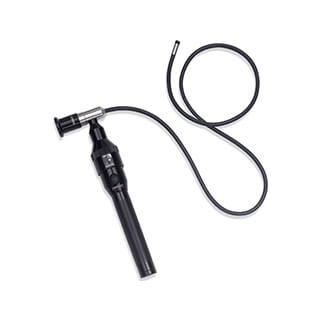- Show results for
- Share
What Should I Look At While Choosing A Borescope? Tips For Buying Borescopes

Contents: |
What is a borescope?
A borescope is a remote inspection tool used to illuminate and magnify objects that are hard to reach or impossible to see directly. It is composed of an optical lens or camera attached to the end of a rigid or flexible tube. The tube feeds into an eyepiece (optical borescope) or display (video borescope) that allows the user to see the remote object.
Modern borescopes allow technicians to capture still images, record videos, and change the viewing position with remote controls. Many are battery-powered, with small displays and low resolution that makes them suitable for both facility and field use. High-end borescopes feature sophisticated controls, enhanced viewing and capture features, and high-resolution displays.
What is a borescope used for?

If you are looking for a guide on how to choose a borescope, then you’re probably aware of its applications - at least the one you need it for. But those - for whom our article is the first stop on their way to learn what exactly a borescope is - may be unsure of its usage.
Generally speaking, borescopes are used for visual inspection work where the inspected area is inaccessible by other means. They help to investigate places that are normally impossible to see into with the naked eye or that require destruction or dismantling to find a problem otherwise.
Borescopes are ideal for numerous applications, including home inspection, automobile maintenance, plumbing service, and HVAC inspection. In aviation, for instance, they are used for inspection of aircraft turbines and engines that require particular attention because of safety and maintenance requirements. And in the manufacturing of machined or cast parts, borescopes are indispensable for inspecting critical interior surfaces for burrs, surface finish, or complete through-holes. Other uses include forensic applications in law enforcement and building inspection, as well as in gunsmithing for inspecting the interior bore of a firearm.
Types of borescopes
According to a vast range of applications, today’s market offers no less diverse variation of borescopes to suit every possible need. Basically, regardless of additional functions and features, all borescopes are divided into three main categories based on the probe type.
 |
 |
 |
|
Rigid Borescopes |
Semi-Rigid Borescopes |
Flexible Borescopes |
| The simplest rigid borescope consists of a hollow stainless steel tube, eyepiece, light source, and relay lenses (typically achromatic, rod, or selfoc). It utilizes a lens system to relay the image from the objective to a relay lens. The image can then be viewed through an eyepiece. Attached to a CCD camera modern borescopes also allow for viewing real-time videos. | Semi-rigid borescopes represent a middle ground between rigid and flexible ones. They are detachable front-end fiber-based instruments with a rigid sheathing surrounding the insertion probe. These products perform optically like a fiberscope but physically like a rigid borescope. They feature a high level of durability and ease of customization for challenging applications. | Flexible borescopes, also known as fiberscopes, can bend and articulate to a comparatively longer distance. They use fiber-optic lenses attached within a sheath on the device rather than lenses to transmit an image to the eyepiece. This allows users to navigate through small and challenging areas and makes fiberscopes an ideal solution for hard-to-reach places. |
What is the difference between borescope and endoscope?

The word endoscope is actually the term used to describe the same tool but it’s specifically used for medical purposes on human or animal bodies. This term sometimes is incorrectly used to describe borescopes for industrial use, which causes some confusion. That is why you see many products listings with multiple titles. Basically, all these tools function the same way but differ according to application.
What is the difference between videoscope and borescope?

Browsing for a borescope, you’ll certainly come across a similar device, called a videoscope or digital inspection
camera. Confusing at a first glance, there is actually a significant reason for that.
A videoscope, also called
an inspection camera, is an advanced borescope that uses image sensors to relay images to an operator. The key
feature of any video borescope is the ability to capture still or live images by means of a miniature camera,
integrated into the tip of the insertion probe.
What is an articulating borescope?
Borescopes or inspection cameras are divided into two types: articulating and non-articulating. The former features a small probe tip, which can be bent in different directions to get better views. It gives the operator more control over the inspection, which is particularly useful when examining small or complex spaces.
There are three types of articulation:
- One-way articulation: bending only in 1 direction
- Two-way articulation: probe bends in 2 directions, right and left
- Four-way articulation: probe bends in 4 directions, right and left, up and down
Some modern borescopes come with joystick 360 all-around articulation - the probe is steered by a joystick to bend in 360 degrees in all directions. The steering can be manual mechanical or driven by an electronic motor.

Articulation provides lots of benefits while the drawback is only one - the price. But do not break the piggy bank. A non-articulating videoscope will perfectly cope with the most of tasks, so spending more on its articulating analog is not a must.
How to Choose a Borescope?
With a variety of borescopes present on the market nowadays, it’s difficult to choose a quality device that exactly suits your needs and not overpay. To that end, we have prepared for you a checklist of things to consider while choosing a borescope:
- Application - certainly the first point in the list. Whatever device you are looking for, your choice is always driven by your needs. Obviously, plumbing borescopes and fiberscopes for mechanics can be interchangeable sometimes, but they still have some essential differences. For the best performance, we advise you to look for a device designed specifically for your application or the one related to it.
- Type of the probe - as we figured out earlier, borescopes differ based on the probe flexibility. Due to different operating principles, rigid borescopes are cheaper, more durable, and provide better image quality compared to fiberscopes. On the other hand, the latter provides flexibility, absolutely necessary for inspection of hard-to-reach places. Going for a semi-rigid model may be a compromise, but still, it all depends on your application.
- Probe length and diameter - estimate the parameters of the objects you are going to inspect. Of course, the probe should not be shorter than the distance from you to your desired target, otherwise, you won’t get the expected results. As for the diameter, choose the borescope based on the narrowest inspected object. In this way, if the aperture is only 7 mm, look for a 6 mm probe. Do not go further - there is no use in buying a borescope with a smaller diameter. Remember, the slimmer the probe the higher the price and the lower the image quality. Try to strike a balance.

- Articulation - buying a videoscope you may choose a so-called entry-level model with a no-articulating tip or go for an advanced solution with 1-, 2-, and 4-way articulation. This feature implies additional expenses but provides a significantly better performance inspecting an object with a non-straight build. Simply put, if your task is to see into construction with a lot of bends - articulation is indispensable (go to What is an articulating borescope? to learn more).
- Image quality - this point is all about resolution. As any other imaging device, borescopes differ due to the image quality they provide. The rule is obvious and simple - the higher resolution the sharper image. You can find a borescope with full HD however, for most applications, 640 x 480 px is enough.
- Field of view - consider the borescope’s range and depth of field view. Some cameras are calibrated to look at objects closer up while others are designed to see farther away and with a greater depth of field to clearly view a larger area.
- Focus - related factor to figure in. Looking for a borescope you may find devices with
autofocus, manual focus, or fixed focus. The difference is simple:
- Autofocus uses a motor to focus on an automatically selected point or area.
- Manual focus requires the user to adjust the focus on the lens by hand.
- Fixed focus implies no adjusting. It is set at the time of lens design and remains fixed.
Focusable borescopes feature a broad magnification range and allow you to see clearly both within close-ups or far away. They provide more versatility compared to fixed-focus models. Alternatively, you can choose the proper focus range of a fixed-focus model and save money with no compromise on quality.
- Focus range - the distance between the nearest and the farthest objects that are in acceptably
sharp focus. The range can be:
- Near-focus (2mm to 20mm)
- Middle-focus (10mm to 50mm)
- Far-focus (50mm to infinity)
Most fixed-focus borescopes or inspection cameras feature middle- or far-focus range. If you need to get a very close-up image, consider buying a focusable device.
- Video recording function - most digital borescopes are recordable. Photos and videos can be taken and stored on your devices either through a photo folder in your computer, phone, or tablet or through an SD card where files can be later transferred to these devices.
- Display types - this point is essential if you are looking for a videoscope. Optical borescopes allow investigation only through an eyepiece, whereas digital inspection cameras provide several options. USB borescopes are designed much like a computer web camera to work directly with computers, mobile phones, and tablets. Some borescopes come equipped with a built-in LCD screen for viewing without a separate device. Another type is a Wi-Fi borescope, which uses a Wi-Fi signal to connect to a device or monitor. There are also separate Wi-Fi converters available that convert your USB device into a Wi-Fi one.

- Special features - depending on its application, borescope may have some additional functions. For instance, if you are going to inspect an engine, you’d better consider buying an oilproof model. Some models, called dual-camera borescopes, come with a side camera in addition to a regular front-facing one, which allows looking either ahead or from the side at a 90-degree angle. One may also need a high-temperature borescope (able to withstand up to 570°F), a borescope with a UV LED lights source for NDT applications, a thermal or night vision borescope, and such. Difficult to find on the market, they are indispensable for some specific applications.
Conclusion
Choosing the right borescope requires specific knowledge and a prudent attitude. You should foresee all the challenges you may come across during the inspection to choose the device that will provide the best performance and simplify your work. Try to find a comfortable range in buying a borescope that does not sacrifice quality but also does not compromise your budget. This ensures you get the best value out of your purchase.






